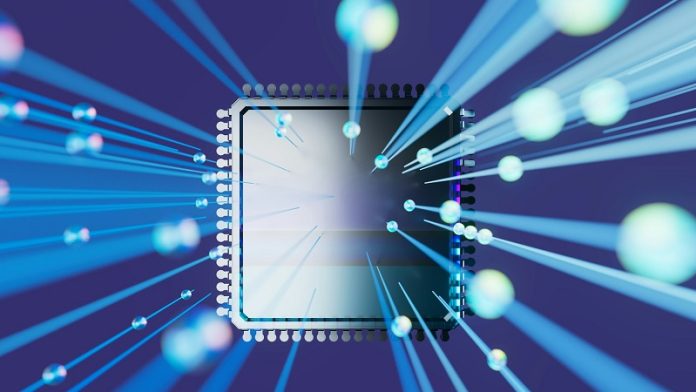
Researchers at Cornell University, in collaboration with the Polish Academy of Sciences, have developed a groundbreaking semiconductor chip that can perform both electronic and photonic functions at the same time.
This “dualtronic” chip could revolutionize the design of electronic devices, making them smaller, more energy-efficient, and cheaper to manufacture.
The research was published on September 25 in Nature.
The key material in this innovation is gallium nitride (GaN), a semiconductor already known for its use in high-frequency electronics and energy-efficient LED lighting.
What makes GaN special is that its two sides have very different physical and chemical properties.
One side, known as the gallium or cation side, is great for photonic devices like LEDs and lasers, while the other side, the nitrogen or anion side, can host transistors.
Until now, no one has been able to create a device that uses both sides of a semiconductor wafer simultaneously for different functions.
Led by Debdeep Jena and Huili Grace Xing, both professors at Cornell, the research team set out to create a chip where one side has a high electron mobility transistor (HEMT) and the other side has a light-emitting diode (LED).
This is something that has never been done with any material before.
The project began at Cornell when Jena, along with former postdoctoral researcher Henryk Turski, conceived the idea of using both faces of a GaN wafer.
Turski, who is now a co-senior author of the paper, collaborated with a team at the Polish Academy of Sciences’ Institute of High Pressure Physics to grow transparent GaN substrates on a single crystal wafer about 400 microns thick.
In Poland, the team grew the HEMT and LED structures using a process called molecular beam epitaxy. Once the chip was ready, it was sent to Cornell, where Eungkyun Kim, a doctoral student, built and processed the HEMT on the nitrogen polar side.
The challenge with this side is that it is more chemically reactive, which makes it easier to damage during processing. Kim had to carefully develop new processes to ensure the transistors were not damaged.
On the other side, Len van Deurzen, another doctoral student, built the LED on the gallium polar side. He protected the nitrogen polar side with a thick coating to ensure it wasn’t affected during the LED construction.
After each step, the team tested the devices to ensure they were still working, and to their surprise, the devices remained stable.
To test the new dual-sided chip, the researchers had to invent a new method. They used a simple double-sided glass plate and wire-bonded one side of the wafer to it, allowing them to test both sides simultaneously.
Because the GaN substrate is transparent, they could see the light pass through it. The HEMT successfully powered the LED, turning it on and off at kilohertz frequencies, which is fast enough for a functional LED display.
This dualtronic chip has many potential applications. For example, current LED displays require separate transistors, which are fabricated independently. With this new chip, the components are combined, making the device smaller, more energy-efficient, and quicker to manufacture. This could lead to cheaper and more efficient microLEDs.
Debdeep Jena compares this innovation to the iPhone, which is not just a phone but also a calculator, a map, and a way to access the internet. Similarly, this dualtronic chip converges multiple functions into one device, reducing the need for different processors and the energy lost in connecting them.
The chip’s potential extends beyond LEDs. It could be used in Complementary Metal-Oxide-Semiconductor (CMOS) devices, with different types of transistors on each side.
It could also be used in 5G and 6G communications, where the GaN’s high piezoelectric properties could filter and amplify signals. Additionally, the chip could incorporate lasers for light-based communication, known as “LiFi.”
As van Deurzen notes, the possibilities are limited only by imagination. This dualtronic chip could open up a whole new world of unexplored functionalities in future technologies.
Source: Cornell University.



